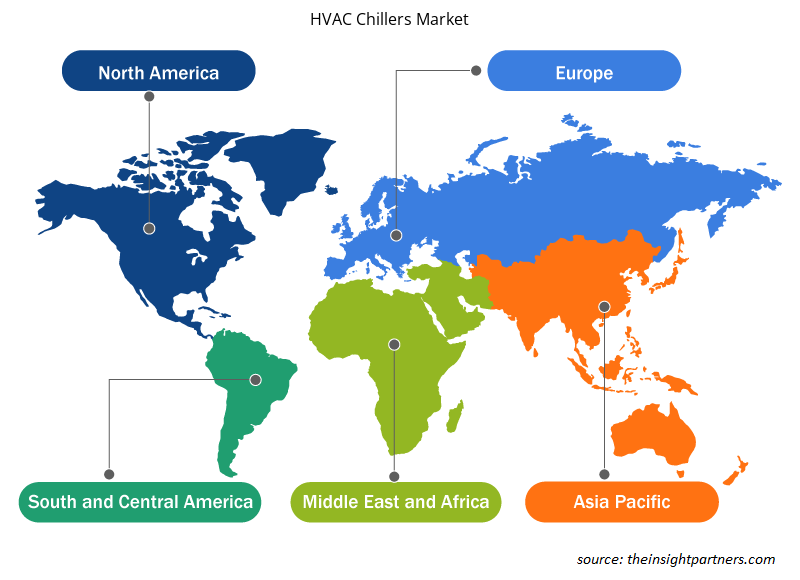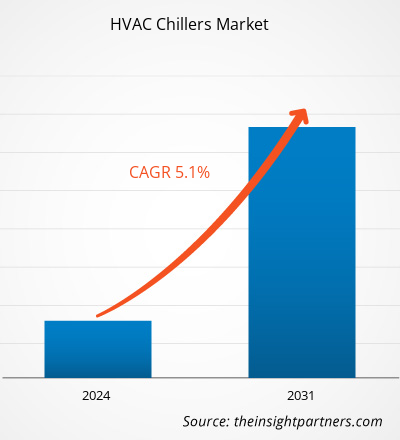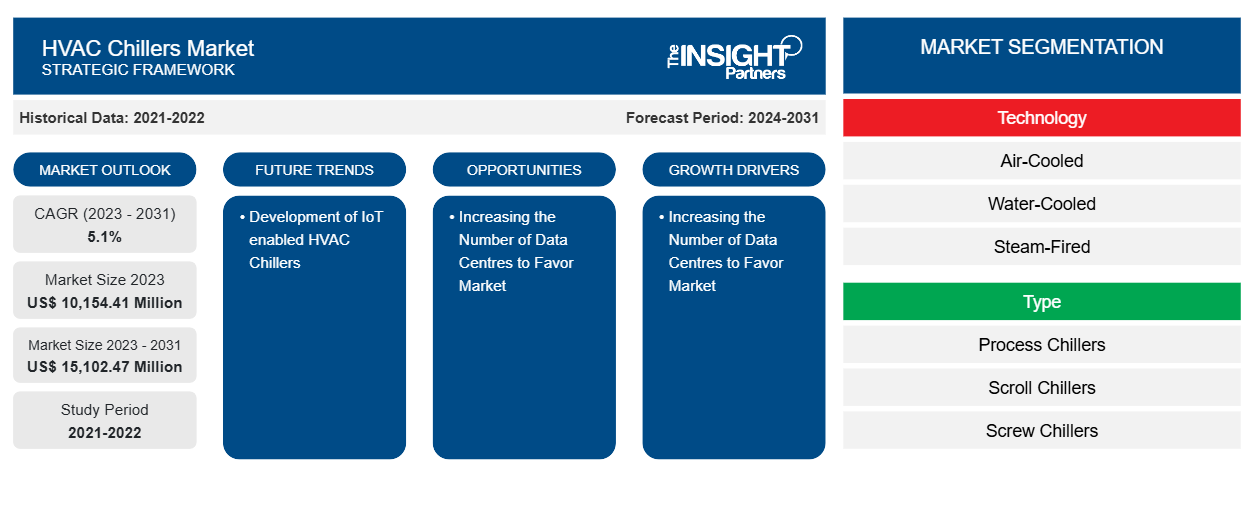Der Markt für HVAC-Kühlgeräte soll von 10.154,41 Millionen US-Dollar im Jahr 2023 auf 15.102,47 Millionen US-Dollar im Jahr 2031 anwachsen. Der Markt wird zwischen 2023 und 2031 voraussichtlich eine durchschnittliche jährliche Wachstumsrate von 5,1 % verzeichnen. Die dynamischen und vielversprechenden Wirtschaftsaussichten in Entwicklungsländern und der technologische Fortschritt in verschiedenen asiatischen Ländern dürften weiterhin ein wichtiger Trend auf dem Markt bleiben.
Marktanalyse für HVAC-Kühlgeräte
Die steigende Nachfrage nach Smart Homes, die zunehmende Industrialisierung und Urbanisierung verstärken die Nachfrage nach HVAC-Kühlern weltweit. Darüber hinaus hat der wachsende Fokus auf den Bau von Wolkenkratzern in China und Japan das Bewusstsein für gekühlte wassergekühlte Systeme erhöht und bietet neue Möglichkeiten, die Nachfrage nach HVAC-Kühlern weltweit anzukurbeln. Extreme Wetterbedingungen, wachsende Bevölkerung, Wachstum bei Infrastruktur- und Stadtentwicklungsprojekten und zunehmende Bedenken hinsichtlich des Gesundheitswesens sind einige der Schlüsselfaktoren, die globale Akteure dazu zwingen werden, in das Geschäft mit Heizung, Lüftung und Klimaanlagen zu investieren. Darüber hinaus wird erwartet, dass die wachsende Bauindustrie zusammen mit Hotels und Restaurants das Wachstum des Marktes für HVAC-Kühler fördern wird.
Marktübersicht für HVAC-Kühlgeräte
Zu den wichtigsten Stakeholdern im globalen Ökosystem des Marktes für HVAC-Kühlgeräte zählen Rohstofflieferanten, Hersteller von HVAC-Kühlgeräten und Endverbraucher. Der Rohstofflieferant ist ein entscheidender Stakeholder im Ökosystem des Marktes für HVAC-Kühlgeräte. Die wichtigsten Rohstoffe sind Silizium, Edelstahl, Hybrid und andere Materialien, die hauptsächlich zur Herstellung der HVAC-Kühlgeräte verwendet werden. Zu den wichtigsten Rohstofflieferanten zählen ASTM International, National Bearings, Kineco Limited, Morgan Advanced Materials usw. ASTM International, ein Rohstofflieferant für Lager, hat sieben neue gesponserte Research to Standards (R2S)-Projekte angekündigt, um das Additive Manufacturing Center of Excellence (AM CoE) von ASTM und sein Ziel zu unterstützen, die AM-Standardisierung und die Einführung in der Industrie zu beschleunigen. Infolgedessen verbessern verstärkte Aktivitäten der Rohstofflieferanten die Produktion von HVAC-Kühlgeräten und treiben das Marktwachstum voran.
Passen Sie diesen Bericht Ihren Anforderungen an
Sie erhalten kostenlos individuelle Anpassungen an jedem Bericht, einschließlich Teilen dieses Berichts oder einer Analyse auf Länderebene, eines Excel-Datenpakets sowie tolle Angebote und Rabatte für Start-ups und Universitäten.
-
Holen Sie sich die wichtigsten Markttrends aus diesem Bericht.Dieses KOSTENLOSE Beispiel umfasst eine Datenanalyse von Markttrends bis hin zu Schätzungen und Prognosen.
Markttreiber und Chancen für HVAC-Kühlgeräte
Erhöhung der Anzahl von Rechenzentren zur Förderung des MarktesCentres to Favor Market
Die zunehmende Stadtentwicklung und die Verbreitung fortschrittlicher Technologien haben zusammen mit der wachsenden Bevölkerung zu einem hohen Energiebedarf und -verbrauch geführt, weshalb weltweit immer mehr energieeffiziente HLK-Kältemaschinen eingesetzt werden. Darüber hinaus werden immer mehr HLK-Kältemaschinen installiert, da die neuen HLK-Technologien KI zur Maximierung der Produktivität nutzen. Die steigende Zahl von Rechenzentren dürfte in naher Zukunft das Wachstum des Marktes für Kältemaschinen weltweit vorantreiben. Rechenzentren benötigen viel Energie, und der Hauptantrieb der Arbeit von Konstrukteuren für Rechenzentren besteht darin, zuverlässige, energieeffiziente und kostengünstige HLK-Systeme anzubieten, die als wichtiger Treiber für den Markt fungieren.HVAC chillers globally. Moreover, there is a rise in the installation of HVAC chiller as the new HVAC technologies use AI to maximize productivity. The rise in the count of HVAC systems, which are acting as a major driver for the market.
Wirtschaftswachstum in Entwicklungsländern weltweit
Positive Wirtschaftsaussichten in Entwicklungsländern wie China und Japan ermöglichen die Entwicklung des Marktes für HVAC-Kühlgeräte. Der Markt für HVAC-Kühlgeräte wächst aufgrund kommerzieller Bauprojekte sowie einer wachsenden Zahl von Einkaufszentren und Einzelhandelsgeschäften. Der hohe Lebensstandard und die steigenden Gesundheitsausgaben erhöhen die Nachfrage nach HVAC-Kühlgeräten in den Industrieländern. Darüber hinaus wird erwartet, dass die steigende Nachfrage nach Kühleinheiten kleiner und mittlerer Leistung in Südeuropa die Produktnachfrage in der Region ankurbelt, was voraussichtlich auch das Wachstum des Marktes für HVAC-Kühlgeräte weltweit in den kommenden Jahren vorantreiben wird.HVAC chillers market. The HVAC chiller market is growing due to commercial construction projects along with a growing number of shopping complexes and retail stores. High standard of living and rise in health expenditure augment the demand for HVAC chiller in the developed nations. Furthermore, increasing demand for small- and medium-power cooler units in Southern Europe is anticipated to drive the product demand in the region, which is also projected to drive the growth of the HVAC chillers market globally over the coming years.
Segmentierungsanalyse des Marktberichts für HVAC-Kühlgeräte Chillers Market Report Segmentation Analysis
Wichtige Segmente, die zur Ableitung der Marktanalyse für HVAC-Kühlgeräte beigetragen haben, sind Technologie, Typ und Anwendung.HVAC chillers market analysis are technology, type, and application.
- Basierend auf der Technologie ist der Markt für HVAC-Kältemaschinen in luftgekühlte, wassergekühlte und dampfbefeuerte unterteilt. Das luftgekühlte Segment hatte im Jahr 2023 einen größeren Marktanteil.
- Basierend auf dem Typ ist der Markt für HVAC-Kältemaschinen in Prozesskältemaschinen, Scroll-Kältemaschinen, Schraubenkältemaschinen , Kreiselkältemaschinen und Absorptionskältemaschinen unterteilt. Das Segment der Schraubenkältemaschinen hatte im Jahr 2023 einen größeren Marktanteil.
- Basierend auf der Anwendung ist der Markt für HVAC-Kühlgeräte in gewerbliche, industrielle und private unterteilt. Das Industriesegment hatte im Jahr 2023 einen größeren Marktanteil.
Marktanteilsanalyse für HVAC-Kühlgeräte nach geografischer Lage
Der geografische Umfang des Marktberichts für HVAC-Kühlgeräte ist hauptsächlich in fünf Regionen unterteilt: Nordamerika, Asien-Pazifik, Europa, Naher Osten und Afrika sowie Süd- und Mittelamerika.
Der asiatisch-pazifische Raum ist Marktführer. Regierungsbemühungen im asiatisch-pazifischen Raum, wie die Initiativen „Make in India“ und „Make in China“, um den Fertigungssektor des Landes zu stärken, würden auch der HVAC-Kühlgerätebranche zugute kommen. Die wachsende Entwicklung in den Bereichen Fertigung, Bergbau und Luftfahrt treibt die Nachfrage nach HVAC-Kühlgeräten im asiatisch-pazifischen Raum an.
Regionale Einblicke in den Markt für HVAC-Kühlgeräte
Die regionalen Trends und Faktoren, die den Markt für HVAC-Kühlgeräte im Prognosezeitraum beeinflussen, wurden von den Analysten von Insight Partners ausführlich erläutert. In diesem Abschnitt werden auch die Marktsegmente und die Geografie von HVAC-Kühlgeräten in Nordamerika, Europa, im asiatisch-pazifischen Raum, im Nahen Osten und Afrika sowie in Süd- und Mittelamerika erörtert.

- Erhalten Sie regionale Daten zum Markt für HVAC-Kühlgeräte
Umfang des Marktberichts zu HVAC-Kühlgeräten
| Berichtsattribut | Details |
|---|---|
| Marktgröße im Jahr 2023 | 10.154,41 Millionen US-Dollar |
| Marktgröße bis 2031 | 15.102,47 Millionen US-Dollar |
| Globale CAGR (2023 - 2031) | 5,1 % |
| Historische Daten | 2021-2022 |
| Prognosezeitraum | 2024–2031 |
| Abgedeckte Segmente |
Nach Technologie
|
| Abgedeckte Regionen und Länder |
Nordamerika
|
| Marktführer und wichtige Unternehmensprofile |
|
Marktteilnehmerdichte: Der Einfluss auf die Geschäftsdynamik
Der Markt für HVAC-Kühlgeräte wächst rasant, angetrieben durch die steigende Endverbrauchernachfrage aufgrund von Faktoren wie sich entwickelnden Verbraucherpräferenzen, technologischen Fortschritten und einem größeren Bewusstsein für die Vorteile des Produkts. Mit steigender Nachfrage erweitern Unternehmen ihr Angebot, entwickeln Innovationen, um die Bedürfnisse der Verbraucher zu erfüllen, und nutzen neue Trends, was das Marktwachstum weiter ankurbelt.
Die Marktteilnehmerdichte bezieht sich auf die Verteilung der Firmen oder Unternehmen, die in einem bestimmten Markt oder einer bestimmten Branche tätig sind. Sie gibt an, wie viele Wettbewerber (Marktteilnehmer) in einem bestimmten Marktraum im Verhältnis zu seiner Größe oder seinem gesamten Marktwert präsent sind.
Die wichtigsten auf dem Markt für Heizungs-, Lüftungs- und Klimatechnik (HVAC)-Kühlgeräte tätigen Unternehmen sind:
- LG Electronics
- Mitsubishi Electric Corporation
- Carrier Global Corporation
- DAIKIN INDUSTRIES, Ltd.
- Thermal Care, Inc.
- Trane
Haftungsausschluss : Die oben aufgeführten Unternehmen sind nicht in einer bestimmten Reihenfolge aufgeführt.

- Überblick über die wichtigsten Akteure auf dem Markt für HVAC-Kühlgeräte
Neuigkeiten und aktuelle Entwicklungen zum Markt für HVAC-Kühlgeräte
Der Markt für HVAC-Kältemaschinen wird durch die Erhebung qualitativer und quantitativer Daten nach Primär- und Sekundärforschung bewertet, die wichtige Unternehmensveröffentlichungen, Verbandsdaten und Datenbanken umfasst. Nachfolgend sind einige der Entwicklungen auf dem Markt für HVAC-Kältemaschinen aufgeführt:
- Airedale International Air Conditioning Ltd. gab die Eröffnung einer neuen Produktionsstätte in Virginia, USA, bekannt. Das neue Werk wird Kühllösungen herstellen, um Chancen in der wachsenden Rechenzentrumsbranche zu nutzen. (Quelle: Airedale International Air Conditioning Ltd, Pressemitteilung, November 2022)
- LG Air Conditioning Technologies USA hat den LG Inverter Scroll Heat Pump Chiller (ISHPC) auf den Markt gebracht. (Quelle: LG Air Conditioning Technologies, Pressemitteilung, Januar 2022)
Marktbericht zu HVAC-Kühlgeräten – Abdeckung und Ergebnisse
Der Bericht „Marktgröße und Prognose für HVAC-Kühlgeräte (2021–2031)“ bietet eine detaillierte Analyse des Marktes, die die folgenden Bereiche abdeckt:
- Marktgröße und Prognose für HVAC-Kühlgeräte auf globaler, regionaler und Länderebene für alle wichtigen Marktsegmente, die im Rahmen des Berichts abgedeckt sind
- Markttrends für HVAC-Kältemaschinen sowie Marktdynamik wie Treiber, Einschränkungen und wichtige Chancen
- Detaillierte PEST- und SWOT-Analyse
- Marktanalyse für HVAC-Kältemaschinen mit Abdeckung der wichtigsten Markttrends, des globalen und regionalen Rahmens, der wichtigsten Akteure, der Vorschriften und der jüngsten Marktentwicklungen
- Branchenlandschaft und Wettbewerbsanalyse, die die Marktkonzentration, Heatmap-Analyse, prominente Akteure und aktuelle Entwicklungen auf dem Markt für HVAC-Kältemaschinen umfasst
- Detaillierte Firmenprofile
- Historische Analyse (2 Jahre), Basisjahr, Prognose (7 Jahre) mit CAGR
- PEST- und SWOT-Analyse
- Marktgröße Wert/Volumen – Global, Regional, Land
- Branchen- und Wettbewerbslandschaft
- Excel-Datensatz
Aktuelle Berichte
Erfahrungsberichte
Grund zum Kauf
- Fundierte Entscheidungsfindung
- Marktdynamik verstehen
- Wettbewerbsanalyse
- Kundeneinblicke
- Marktprognosen
- Risikominimierung
- Strategische Planung
- Investitionsbegründung
- Identifizierung neuer Märkte
- Verbesserung von Marketingstrategien
- Steigerung der Betriebseffizienz
- Anpassung an regulatorische Trends























 Kostenlose Probe anfordern für - Markt für HVAC-Kühlgeräte
Kostenlose Probe anfordern für - Markt für HVAC-Kühlgeräte